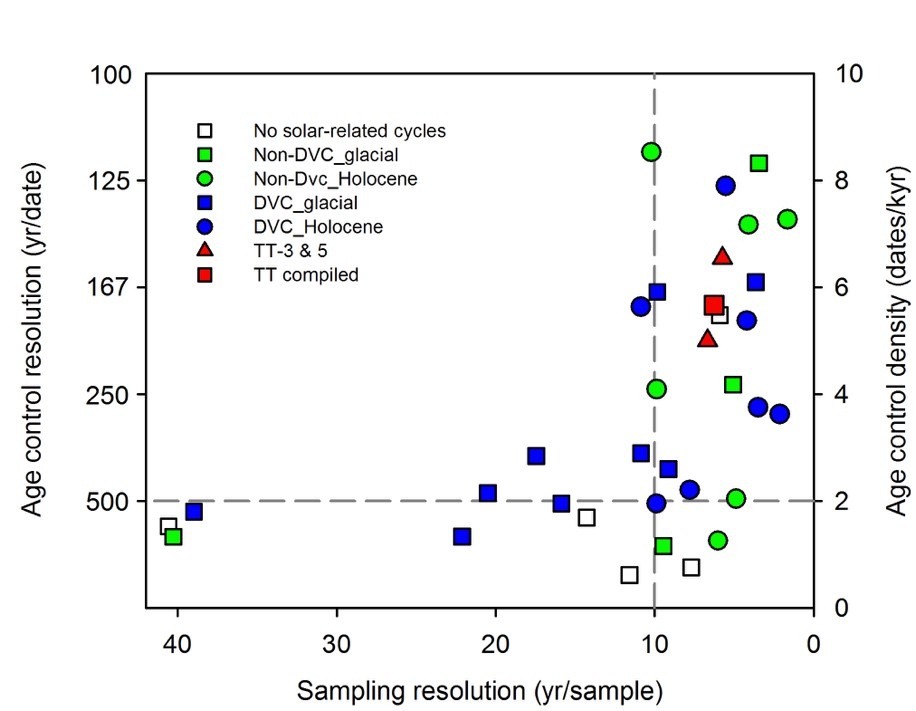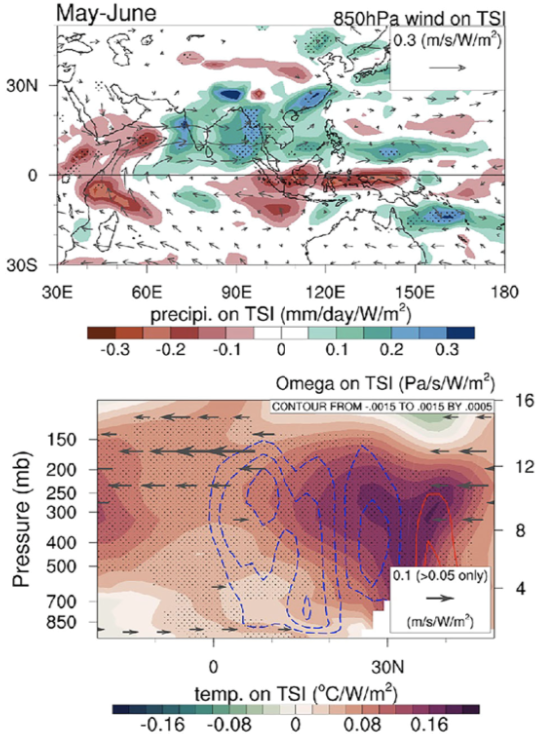


Chronological control points and sampling resolution for the ASM/ISM records. The blue symbols are records with the de Vries cycle, while the greens show the ones with other solar-related cycles. Hollow symbols indicate records without solar-related cycles. Circles and rectangles indicate speleothem δ18O records covering Holocene and last glacial periods, respectively. Compiled TT, TT-3 and TT-5 records are all marked in red.
The Asian summer monsoon variability on centennial to multidecadal timescales is less understood for the reason that it lacks of well-defined climate forcings. Radiatively, the sun is the ultimate source of energy for climatic variations on Earth, so it potentially affects climate via energy balance in all timescales. Sunspot is a direct observation of solar energy output for centennial to decadal timescales, but the instrumental record is too short to provide sufficient evidence for the climate response.
A practical way to know the influence of solar on climate is use proxy data and see if the temporal spectra match the known frequencies of irradiance fluctuations. A growing number of studies indeed suggest that solar activity is a pivotal driving force of climate change in the Holocene. On the contrary, other studies have found that the solar–climate link is not always statistically significant, and may be confounded by other factors including internal mechanisms that cause minor climate variability. This correlation is particularly ambiguous during the glacial period.
Here, we utilize a decadal-resolved speleothem δ18O record from Vietnam (TT) spanning 32.5–27.5 kyr BP, and show a positive coherence between regional precipitation and Total Solar Irradiance (TSI). Spectral analysis on the TT dataset reveals an approximately 180-year periodicity, coinciding with the de Vries cycle of solar activity. Combined 35 other speleothem records, we demonstrate that sufficient age control point is essential for capturing solar-related periodicities. Further extending our findings to a general context, a ratio of 2–3 between age control interval to event frequency is suggested as a reference for detecting a particular cycle.
We then used the Community Earth System Model-Last Millennium Ensemble (CESM–LME) experiments to examine the Asian Monsoon’s response to solar irradiance changes. By conducting a single forcing run, the model simulation shows that TSI could enhance monsoonal circulation and regional precipitation across South and East Asia, particularly during the monsoon onset stage. This is propelled by anomalous warming over the Tibetan Plateau, which favors an augmented updraft and intensified northward cross-equatorial wind near the surface. The precipitation surge consequently manifests on the windward side of India and Indochina. In conclusion, this study underscores the significance of relatively minor radiative forcing in climate dynamics over monsoonal Asia on decadal to centennial timescales. We argue that changes in solar irradiance should be considered in regional climate projections.
Key points
More information

Regression map of climate variables on solar irradiance. (a) Precipitation (shaded) and 850-hPa wind field (vector) coefficients to solar activity obtained by multi-linear regression analysis using LME TSI single forcing experiment. (b) Zonal averaged (60°–90°E) temperature (shaded), omega (contour: blue lines denote anomalous upward motion), and meridional winds (vector). The solid black dots denote the grids where the coefficients are statistically significant at 95% confidence level.